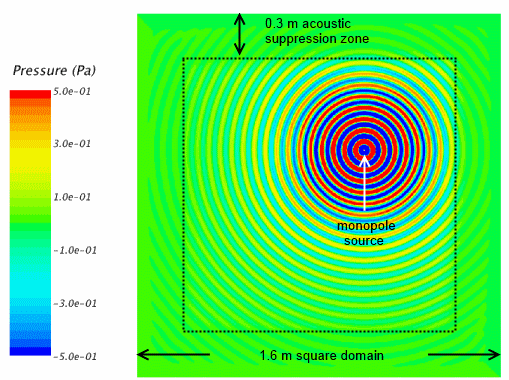Acoustic Suppression Zone Model (Deprecated)
The Acoustic Suppression Zone model suppresses spurious reflective disturbances in unsteady aeroacoustic simulations.
| Note | The Acoustic Suppression Zone model is deprecated and will be removed in a future version. You are advised to use the Sponge Layer model instead. |
Running unsteady flow simulations produces time-dependent variations in the flow. These flow disturbances convect with the flow (for vortical disturbances) or propagate at the speed of sound (for acoustic disturbances) outward to exterior boundaries.
If the applied exterior boundary types have reflective properties, these disturbances can be spuriously reflected back into the domain. This reflection affects the flow solution, causing problems for acoustic-type calculations.
To satisfy the requirements for good quality aeroacoustic calculations, the numerical algorithm must allow these pressure waves and vortices to travel through the boundary smoothly. In other words, the algorithm must give the boundary quasi-non-reflective properties.
For example, a pressure outlet with non-reflecting properties allows the defined constant pressure to represent an average pressure at the outlet boundary. At the same time, it allows the flow pressure at the boundary to vary and disturbances to pass out of the domain without reflecting off the boundary.
A practical approach to constructing a non-reflective boundary treatment is to complement the respective characteristics-based boundary conditions with an Acoustics Suppression Zone treatment.
Use the Acoustic Suppression Zone when:
- Boundary disturbances are creating spurious acoustic effects.
- The spurious acoustic effects are propagating upstream.
- There is enough distance (at least several wavelengths) next to the boundary in which to suppress the spurious acoustic effects.
Example: The following image shows a monopole source which is radiating an instantaneous pressure field at 6800 Hz in a 1.6 m square domain. The simulation ran using the coupled solver. An Acoustic Suppression Zone 0.3 m deep was applied to the boundaries of the domain to suppress echoes.

With experience, you can use the Acoustic Suppression Zone model to model complex far-field conditions (for example, the simulation of wind gust effects on an airfoil), beyond the boundary conditions that are documented here. See Kim et al. [67].